国内外交通信号控制系统综述(论文).docx
- 格式:docx
- 大小:24.17 KB
- 文档页数:5
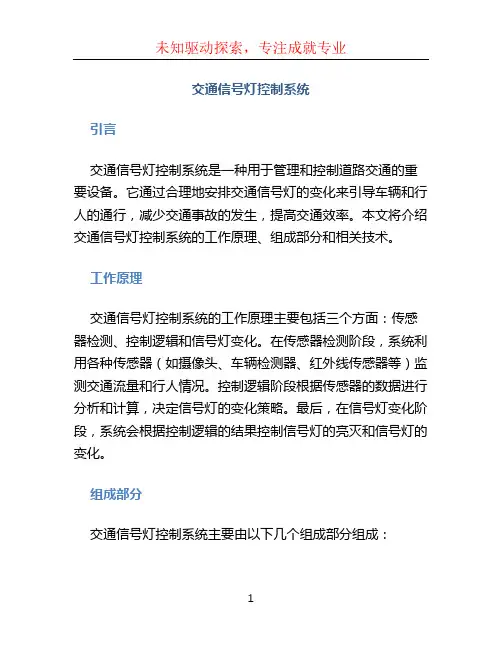
交通信号灯控制系统引言交通信号灯控制系统是一种用于管理和控制道路交通的重要设备。
它通过合理地安排交通信号灯的变化来引导车辆和行人的通行,减少交通事故的发生,提高交通效率。
本文将介绍交通信号灯控制系统的工作原理、组成部分和相关技术。
工作原理交通信号灯控制系统的工作原理主要包括三个方面:传感器检测、控制逻辑和信号灯变化。
在传感器检测阶段,系统利用各种传感器(如摄像头、车辆检测器、红外线传感器等)监测交通流量和行人情况。
控制逻辑阶段根据传感器的数据进行分析和计算,决定信号灯的变化策略。
最后,在信号灯变化阶段,系统会根据控制逻辑的结果控制信号灯的亮灭和信号灯的变化。
组成部分交通信号灯控制系统主要由以下几个组成部分组成:1. 信号灯信号灯是交通信号灯控制系统的核心部分。
它通常由红灯、黄灯和绿灯组成,用于指示车辆和行人的行驶状态。
不同的信号灯组合可以传达不同的交通指示,如停车、行驶和减速等。
2. 控制器控制器是交通信号灯控制系统的核心控制设备。
它负责接收传感器的数据并根据控制逻辑进行信号灯的控制。
现代的交通信号灯控制系统通常采用微处理器控制器,具有较高的智能化和可编程性。
3. 传感器传感器是交通信号灯控制系统的信息获取设备。
它可以通过不同的监测技术获取车辆和行人的信息,并将这些信息传输给控制器进行处理。
常见的传感器包括车辆检测器、行人探测器、摄像头等。
4. 通信设备通信设备用于实现交通信号灯控制系统与其他交通管理系统之间的数据交换和通信。
通过与其他设备的连接,交通信号灯控制系统可以获取更多的交通信息,并做出更加准确的控制决策。
5. 电源系统电源系统为交通信号灯控制系统提供电力支持。
它通常包括电源装置和电池,确保系统可以持续稳定地工作。
相关技术交通信号灯控制系统的发展离不开各种相关技术的支持。
以下是一些常用的交通信号灯控制系统的技术:1. 视频监测技术视频监测技术通过安装摄像头来实时监测交通情况。
利用图像处理算法可以对交通流量进行准确的检测和统计,为交通信号灯的控制提供准确的数据支持。
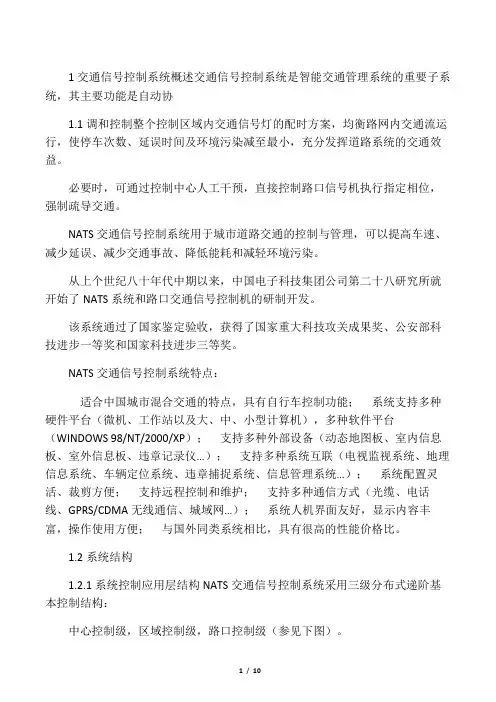
1交通信号控制系统概述交通信号控制系统是智能交通管理系统的重要子系统,其主要功能是自动协1.1调和控制整个控制区域内交通信号灯的配时方案,均衡路网内交通流运行,使停车次数、延误时间及环境污染减至最小,充分发挥道路系统的交通效益。
必要时,可通过控制中心人工干预,直接控制路口信号机执行指定相位,强制疏导交通。
NATS交通信号控制系统用于城市道路交通的控制与管理,可以提高车速、减少延误、减少交通事故、降低能耗和减轻环境污染。
从上个世纪八十年代中期以来,中国电子科技集团公司第二十八研究所就开始了NATS系统和路口交通信号控制机的研制开发。
该系统通过了国家鉴定验收,获得了国家重大科技攻关成果奖、公安部科技进步一等奖和国家科技进步三等奖。
NATS交通信号控制系统特点:适合中国城市混合交通的特点,具有自行车控制功能;系统支持多种硬件平台(微机、工作站以及大、中、小型计算机),多种软件平台(WINDOWS 98/NT/2000/XP);支持多种外部设备(动态地图板、室内信息板、室外信息板、违章记录仪…);支持多种系统互联(电视监视系统、地理信息系统、车辆定位系统、违章捕捉系统、信息管理系统…);系统配置灵活、裁剪方便;支持远程控制和维护;支持多种通信方式(光缆、电话线、GPRS/CDMA无线通信、城域网…);系统人机界面友好,显示内容丰富,操作使用方便;与国外同类系统相比,具有很高的性能价格比。
1.2系统结构1.2.1系统控制应用层结构NATS交通信号控制系统采用三级分布式递阶基本控制结构:中心控制级,区域控制级,路口控制级(参见下图)。
中心控制级区域控制级1区域控制级2路口控制级路口控制级路口控制级区域控制级N1.2.2系统基本结构区域监控台动态地图板室内信息板违章捕捉仪区域控制计算机数据通信控制机(光端机)光纤(光端机)(光端机)路口信号机…(光端机)(光端机)路口信号机室外情报板…室外情报板交通信号灯车辆检测器其中:区域控制计算机监视、控制、协调整个系统的运行,可同时控制128个外部设备,如果外部设备超过128路,可采用多台区域控制计算机。
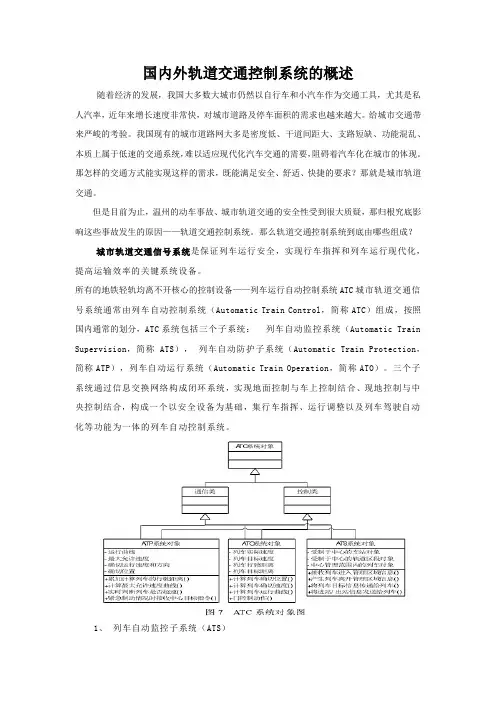
国内外轨道交通控制系统的概述随着经济的发展,我国大多数大城市仍然以自行车和小汽车作为交通工具,尤其是私人汽率,近年来增长速度非常快,对城市道路及停车面积的需求也越来越大。
给城市交通带来严峻的考验。
我国现有的城市道路网大多是密度低、干道间距大、支路短缺、功能混乱、本质上属于低速的交通系统,难以适应现代化汽车交通的需要,阻碍着汽车化在城市的体现。
那怎样的交通方式能实现这样的需求,既能满足安全、舒适、快捷的要求?那就是城市轨道交通。
但是目前为止,温州的动车事故、城市轨道交通的安全性受到很大质疑,那归根究底影响这些事故发生的原因——轨道交通控制系统。
那么轨道交通控制系统到底由哪些组成?城市轨道交通信号系统是保证列车运行安全,实现行车指挥和列车运行现代化,提高运输效率的关键系统设备。
所有的地铁轻轨均离不开核心的控制设备——列车运行自动控制系统ATC城市轨道交通信号系统通常由列车自动控制系统(Automatic Train Control,简称ATC)组成,按照国内通常的划分,ATC系统包括三个子系统:列车自动监控系统(Automatic Train Supervision,简称ATS),列车自动防护子系统(Automatic Train Protection,简称ATP),列车自动运行系统(Automatic Train Operation,简称ATO)。
三个子系统通过信息交换网络构成闭环系统,实现地面控制与车上控制结合、现地控制与中央控制结合,构成一个以安全设备为基础,集行车指挥、运行调整以及列车驾驶自动化等功能为一体的列车自动控制系统。
1、列车自动监控子系统(ATS)ATS系统由控制中心、车站、车场以及车载设备组成。
ATS主要实现对列车运行的监督,辅助调度人员对全线列车运行进行管理,实现以下基本功能:(1)通过ATS车站设备,能够采集轨旁及车载ATP提供的轨道占用状态、进路状态、列车运行状态以及信号设备故障等控制和监督列车运行的基础信息。
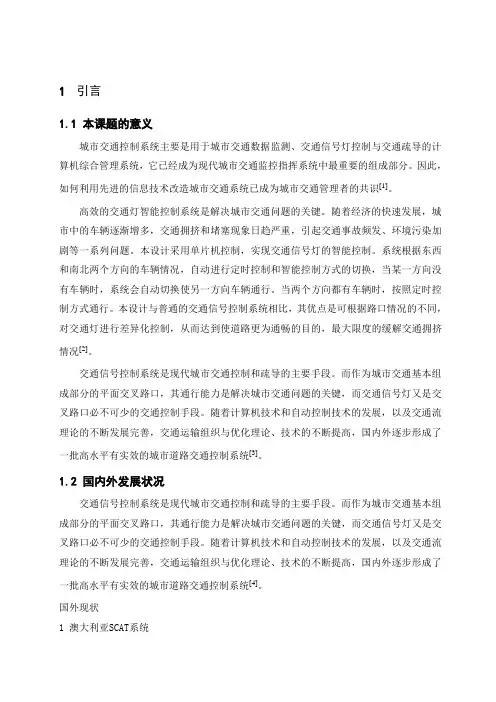
1引言1.1 本课题的意义城市交通控制系统主要是用于城市交通数据监测、交通信号灯控制与交通疏导的计算机综合管理系统,它已经成为现代城市交通监控指挥系统中最重要的组成部分。
因此,如何利用先进的信息技术改造城市交通系统已成为城市交通管理者的共识[1]。
高效的交通灯智能控制系统是解决城市交通问题的关键。
随着经济的快速发展,城市中的车辆逐渐增多,交通拥挤和堵塞现象日趋严重,引起交通事故频发、环境污染加剧等一系列问题。
本设计采用单片机控制,实现交通信号灯的智能控制。
系统根据东西和南北两个方向的车辆情况,自动进行定时控制和智能控制方式的切换,当某一方向没有车辆时,系统会自动切换使另一方向车辆通行。
当两个方向都有车辆时,按照定时控制方式通行。
本设计与普通的交通信号控制系统相比,其优点是可根据路口情况的不同,对交通灯进行差异化控制,从而达到使道路更为通畅的目的,最大限度的缓解交通拥挤情况[2]。
交通信号控制系统是现代城市交通控制和疏导的主要手段。
而作为城市交通基本组成部分的平面交叉路口,其通行能力是解决城市交通问题的关键,而交通信号灯又是交叉路口必不可少的交通控制手段。
随着计算机技术和自动控制技术的发展,以及交通流理论的不断发展完善,交通运输组织与优化理论、技术的不断提高,国内外逐步形成了一批高水平有实效的城市道路交通控制系统[3]。
1.2 国内外发展状况交通信号控制系统是现代城市交通控制和疏导的主要手段。
而作为城市交通基本组成部分的平面交叉路口,其通行能力是解决城市交通问题的关键,而交通信号灯又是交叉路口必不可少的交通控制手段。
随着计算机技术和自动控制技术的发展,以及交通流理论的不断发展完善,交通运输组织与优化理论、技术的不断提高,国内外逐步形成了一批高水平有实效的城市道路交通控制系统[4]。
国外现状1 澳大利亚SCAT系统SCATS采取分层递阶式控制结构。
其控制中心备有一台监控计算机和一台管理计算机,通过串行数据通讯线路相连。
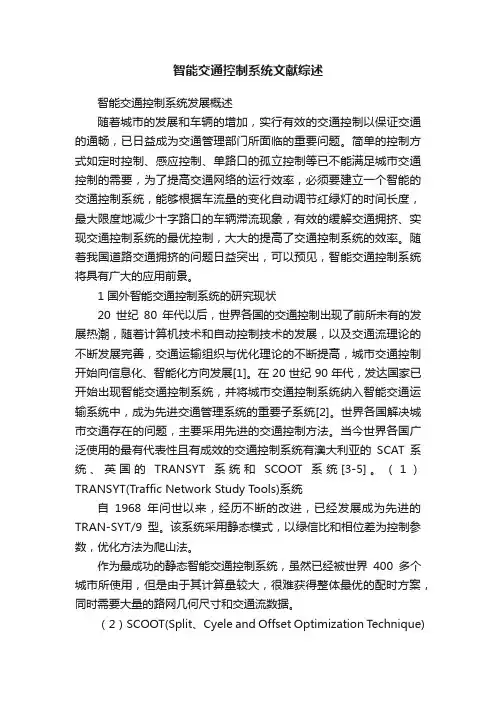
智能交通控制系统文献综述智能交通控制系统发展概述随着城市的发展和车辆的增加,实行有效的交通控制以保证交通的通畅,已日益成为交通管理部门所面临的重要问题。
简单的控制方式如定时控制、感应控制、单路口的孤立控制等已不能满足城市交通控制的需要,为了提高交通网络的运行效率,必须要建立一个智能的交通控制系统,能够根据车流量的变化自动调节红绿灯的时间长度,最大限度地减少十字路口的车辆滞流现象,有效的缓解交通拥挤、实现交通控制系统的最优控制,大大的提高了交通控制系统的效率。
随着我国道路交通拥挤的问题日益突出,可以预见,智能交通控制系统将具有广大的应用前景。
1 国外智能交通控制系统的研究现状20世纪80年代以后,世界各国的交通控制出现了前所未有的发展热潮,随着计算机技术和自动控制技术的发展,以及交通流理论的不断发展完善,交通运输组织与优化理论的不断提高,城市交通控制开始向信息化、智能化方向发展[1]。
在20世纪90年代,发达国家已开始出现智能交通控制系统,并将城市交通控制系统纳入智能交通运输系统中,成为先进交通管理系统的重要子系统[2]。
世界各国解决城市交通存在的问题,主要采用先进的交通控制方法。
当今世界各国广泛使用的最有代表性且有成效的交通控制系统有澳大利亚的SCAT系统、英国的TRANSYT系统和SCOOT系统[3-5]。
(1)TRANSYT(Traffic Network Study Tools)系统自1968年问世以来,经历不断的改进,已经发展成为先进的TRAN-SYT/9型。
该系统采用静态模式,以绿信比和相位差为控制参数,优化方法为爬山法。
作为最成功的静态智能交通控制系统,虽然已经被世界400多个城市所使用,但是由于其计算量较大,很难获得整体最优的配时方案,同时需要大量的路网几何尺寸和交通流数据。
(2)SCOOT(Split、Cyele and Offset Optimization Technique)系统采用联机实时控制的动态模式,对周期、绿信比和相位差进行控制,采用小步长寻优方法,相对TRANSYT 而言具有相当大的优势。
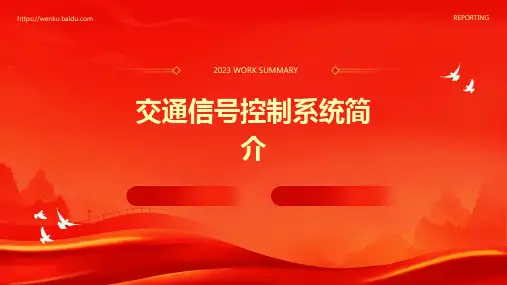
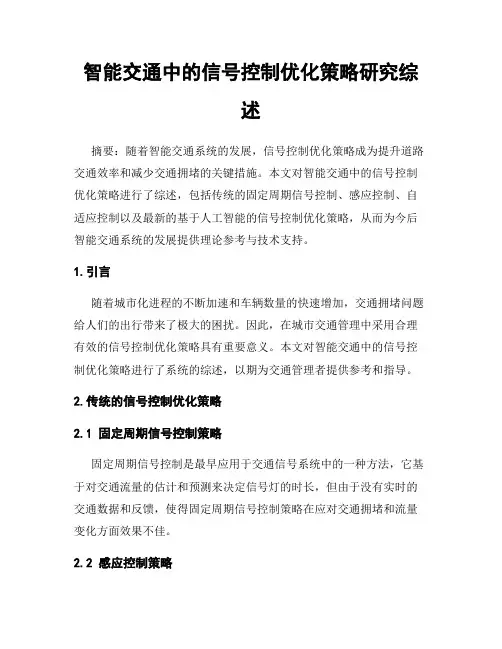
智能交通中的信号控制优化策略研究综述摘要:随着智能交通系统的发展,信号控制优化策略成为提升道路交通效率和减少交通拥堵的关键措施。
本文对智能交通中的信号控制优化策略进行了综述,包括传统的固定周期信号控制、感应控制、自适应控制以及最新的基于人工智能的信号控制优化策略,从而为今后智能交通系统的发展提供理论参考与技术支持。
1.引言随着城市化进程的不断加速和车辆数量的快速增加,交通拥堵问题给人们的出行带来了极大的困扰。
因此,在城市交通管理中采用合理有效的信号控制优化策略具有重要意义。
本文对智能交通中的信号控制优化策略进行了系统的综述,以期为交通管理者提供参考和指导。
2.传统的信号控制优化策略2.1 固定周期信号控制策略固定周期信号控制是最早应用于交通信号系统中的一种方法,它基于对交通流量的估计和预测来决定信号灯的时长,但由于没有实时的交通数据和反馈,使得固定周期信号控制策略在应对交通拥堵和流量变化方面效果不佳。
2.2 感应控制策略感应控制策略通过在交叉口安装感应器,根据感应器捕捉到的交通流量信息来调整信号灯时长,以达到优化交通流动的效果。
该策略能够根据交通流量的实时变化进行灵活调整,但仍存在数据采集和感应器故障的问题。
2.3 自适应控制策略自适应控制策略是利用交通流状态的实时测量或估计信息来调整信号控制策略的方法。
它具有灵活性和适应性,能够根据实时交通状况进行动态调整,但需要大量的交通数据和处理算法支持。
3.智能交通中基于人工智能的信号控制优化策略随着人工智能技术的迅速发展,越来越多的研究关注将人工智能技术应用于信号控制优化中,以实现更高效的交通流动和减少拥堵。
主要的研究方法包括遗传算法、粒子群算法、强化学习等。
3.1 遗传算法遗传算法是一种通过模拟自然选择机制进行搜索和优化的计算方法。
在信号控制优化中,遗传算法可以根据道路网络效益函数和交通数据,通过指定变异和交叉操作来求解最佳的信号控制策略。
3.2 粒子群算法粒子群算法是通过模拟鸟群或鱼群的行为,采用群体智能方法来解决优化问题的一种算法。

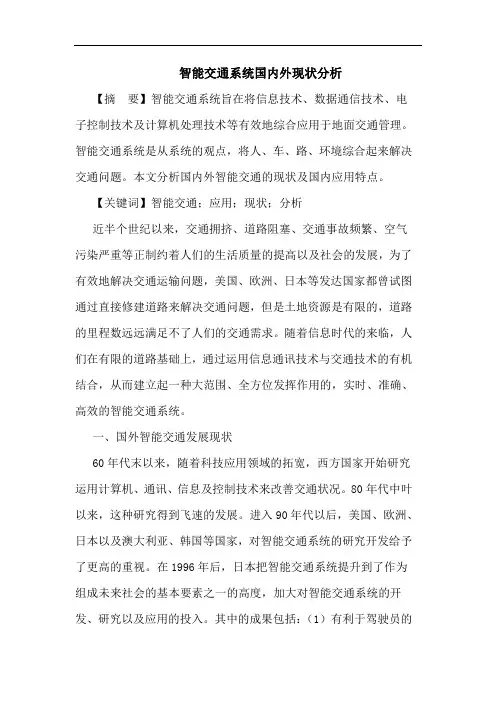
智能交通系统国内外现状分析【摘要】智能交通系统旨在将信息技术、数据通信技术、电子控制技术及计算机处理技术等有效地综合应用于地面交通管理。
智能交通系统是从系统的观点,将人、车、路、环境综合起来解决交通问题。
本文分析国内外智能交通的现状及国内应用特点。
【关键词】智能交通;应用;现状;分析近半个世纪以来,交通拥挤、道路阻塞、交通事故频繁、空气污染严重等正制约着人们的生活质量的提高以及社会的发展,为了有效地解决交通运输问题,美国、欧洲、日本等发达国家都曾试图通过直接修建道路来解决交通问题,但是土地资源是有限的,道路的里程数远远满足不了人们的交通需求。
随着信息时代的来临,人们在有限的道路基础上,通过运用信息通讯技术与交通技术的有机结合,从而建立起一种大范围、全方位发挥作用的,实时、准确、高效的智能交通系统。
一、国外智能交通发展现状60年代末以来,随着科技应用领域的拓宽,西方国家开始研究运用计算机、通讯、信息及控制技术来改善交通状况。
80年代中叶以来,这种研究得到飞速的发展。
进入90年代以后,美国、欧洲、日本以及澳大利亚、韩国等国家,对智能交通系统的研究开发给予了更高的重视。
在1996年后,日本把智能交通系统提升到了作为组成未来社会的基本要素之一的高度,加大对智能交通系统的开发、研究以及应用的投入。
其中的成果包括:(1)有利于驾驶员的导航系统。
为了使驾驶员在驾驶中可以采用最佳行动,通过分散交通流等为驾驶员提供便利,将经由路线的堵塞信息、所需时间、交通管制信息、停车场的满空信息等提供给驾驶员。
日本在全国重要城市的道路上实施了一种名为“汽车信息和通信系统(vics)”能接收信息的最新技术。
(2)公路自动收费系统。
日本的收费公路超过了8000km,有必要开发出适合全日本收费公路的自动收费系统。
为此日本安装了etc,基于dsrc,通过交互通信将汽车和道路联系起来,ic卡与安装etc 车道上的无线装置联系,记录收费信息。
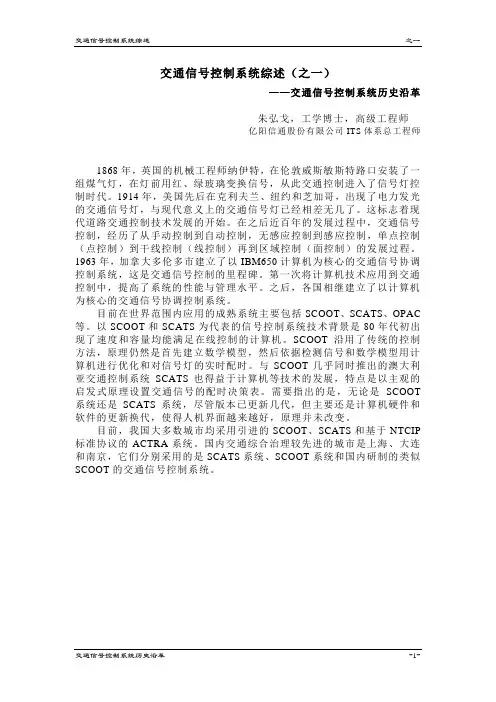
交通信号控制系统综述(之一)——交通信号控制系统历史沿革朱弘戈,工学博士,高级工程师亿阳信通股份有限公司ITS体系总工程师1868年,英国的机械工程师纳伊特,在伦敦威斯敏斯特路口安装了一组煤气灯,在灯前用红、绿玻璃变换信号,从此交通控制进入了信号灯控制时代。
1914年,美国先后在克利夫兰、纽约和芝加哥,出现了电力发光的交通信号灯,与现代意义上的交通信号灯已经相差无几了。
这标志着现代道路交通控制技术发展的开始。
在之后近百年的发展过程中,交通信号控制,经历了从手动控制到自动控制,无感应控制到感应控制,单点控制(点控制)到干线控制(线控制)再到区域控制(面控制)的发展过程。
1963年,加拿大多伦多市建立了以IBM650计算机为核心的交通信号协调控制系统,这是交通信号控制的里程碑。
第一次将计算机技术应用到交通控制中,提高了系统的性能与管理水平。
之后,各国相继建立了以计算机为核心的交通信号协调控制系统。
目前在世界范围内应用的成熟系统主要包括SCOOT、SCATS、OPAC 等。
以SCOOT和SCATS为代表的信号控制系统技术背景是80年代初出现了速度和容量均能满足在线控制的计算机。
SCOOT沿用了传统的控制方法,原理仍然是首先建立数学模型,然后依据检测信号和数学模型用计算机进行优化和对信号灯的实时配时。
与SCOOT几乎同时推出的澳大利亚交通控制系统SCATS也得益于计算机等技术的发展,特点是以主观的启发式原理设置交通信号的配时决策表。
需要指出的是,无论是SCOOT 系统还是SCATS系统,尽管版本已更新几代,但主要还是计算机硬件和软件的更新换代,使得人机界面越来越好,原理并未改变。
目前,我国大多数城市均采用引进的SCOOT、SCATS和基于NTCIP 标准协议的ACTRA系统。
国内交通综合治理较先进的城市是上海、大连和南京,它们分别采用的是SCATS系统、SCOOT系统和国内研制的类似SCOOT的交通信号控制系统。
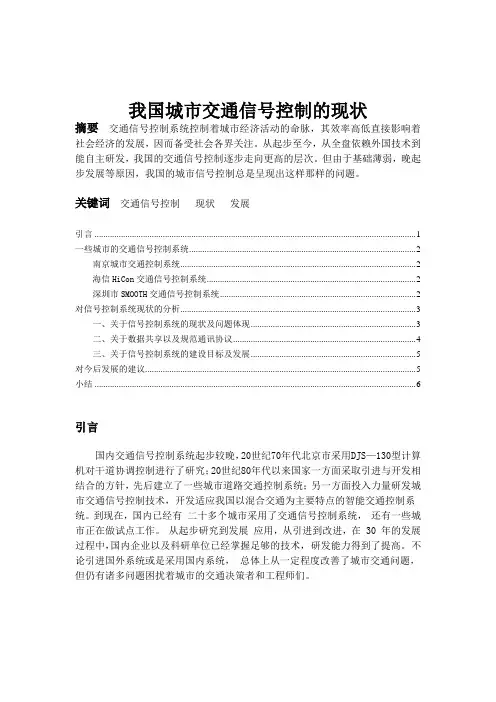
我国城市交通信号控制的现状摘要交通信号控制系统控制着城市经济活动的命脉,其效率高低直接影响着社会经济的发展,因而备受社会各界关注。
从起步至今,从全盘依赖外国技术到能自主研发,我国的交通信号控制逐步走向更高的层次。
但由于基础薄弱,晚起步发展等原因,我国的城市信号控制总是呈现出这样那样的问题。
关键词交通信号控制现状发展引言 (1)一些城市的交通信号控制系统 (2)南京城市交通控制系统 (2)海信HiCon交通信号控制系统 (2)深圳市SMOOTH交通信号控制系统 (2)对信号控制系统现状的分析 (3)一、关于信号控制系统的现状及问题体现 (3)二、关于数据共享以及规范通讯协议 (4)三、关于信号控制系统的建设目标及发展 (5)对今后发展的建议 (5)小结 (6)引言国内交通信号控制系统起步较晚,20世纪70年代北京市采用DJS—130型计算机对干道协调控制进行了研究;20世纪80年代以来国家一方面采取引进与开发相结合的方针,先后建立了一些城市道路交通控制系统;另一方面投入力量研发城市交通信号控制技术,开发适应我国以混合交通为主要特点的智能交通控制系统。
到现在,国内已经有二十多个城市采用了交通信号控制系统,还有一些城市正在做试点工作。
从起步研究到发展应用,从引进到改进,在 30 年的发展过程中,国内企业以及科研单位已经掌握足够的技术,研发能力得到了提高。
不论引进国外系统或是采用国内系统,总体上从一定程度改善了城市交通问题,但仍有诸多问题困扰着城市的交通决策者和工程师们。
一些城市的交通信号控制系统南京城市交通控制系统南京城市交通控制系统(简称NUTCS)是我国自行研制开发的第一个实时自适应城市交通信号控制系统,是在原国家计委和国家科委的批准下,由交通部、公安部和南京市共同完成的,是“七五”国家重点科技攻关项目(编号2443),多次获得公安部和国家的技术大奖。
NUTCS结合了SCOOT与SCATS的优点,满足和适应国内路网密度低而且路口间距悬殊的道路条件以及混合交通突出的交通特点;通常采用路口级和区域级两级控制结构,需要的情况下可以扩充为路口级、区域级和中心级三级分布式递阶控制结构;系统设置了实时自适应、固定配时和无电缆联动控制三种模式,具有警卫、消防、救护、公交信号以及人工指定等功能,工作方式灵活,功能完备。
Agent controlled traffic lightsAuthor:Danko A. Roozemond,Jan L.H. RogierProvenance:Delft University of Technology IntroductionThe quality of (urban) traffic control systems is determined by the match between the control schema and the actual traffic patterns. If traffic patterns change, what they usually do, the effectiveness is determined by the way in which the system adapts to these changes. When this ability to adapt becomes an integral part of the traffic control unit it can react better to changes in traffic conditions. Adjusting a traffic control unit is a costly and timely affair if it involves human attention. The hypothesis is that it might offer additional benefit using self-evaluating and self-adjusting traffic control systems. There is already a market for an urban traffic control system that is able to react if the environment changes;the so called adaptive systems. "Real" adaptive systems will need pro-active calculated traffic information and cycle plans- based on these calculated traffic conditions- to be updated frequently.Our research of the usability of agent technology within traffic control can be split into two parts. First there is a theoretical part integrating agent technology and traffic control. The final stage of this research focuses on practical issues like implementation and performance. Here we present the concepts of agent technology applied to dynamic traffic control. Currently we are designing a layered model of an agent based urban traffic control system. We will elaborate on that in the last chapters.Adaptive urban traffic controlAdaptive signal control systems must have a capability to optimise the traffic flow by adjusting the traffic signals based on current traffic. All used traffic signal control methods are based on feed-back algorithms using traffic demand data -varying from years to a couple of minutes - in the past. Current adaptive systems often operate on the basis of adaptive green phases and flexible co-ordination in (sub)networks based on measured traffic conditions (e.g., UTOPIA-spot,SCOOT). These methods are still not optimal where traffic demand changes rapidly within a short time interval. The basic premise is that existing signal plan generation tools make rational decisions about signal plans under varying conditions; but almost none of the current available tools behave pro-actively or have meta-rules that may change behaviour of the controller incorporated into the system. The next logical step for traffic control is the inclusion of these meta-rules and pro active and goal-oriented behaviour. The key aspects of improved control, for which contributions from artificial intelligence and artificial intelligent agents can be expected, include the capability of dealing with conflicting objectives; the capability of making pro-active decisions on the basis of temporal analysis; the ability of managing, learning, self adjusting and responding to non-recurrent and unexpected events (Ambrosino et al.., 1994).What are intelligent agentsAgent technology is a new concept within the artificial intelligence (AI). The agent paradigm in AI is based upon the notion of reactive, autonomous, internally-motivated entities that inhabit dynamic, not necessarily fully predictable environments (Weiss, 1999). Autonomy is the ability to function as an independent unit over an extended period of time, performing a variety of actions necessary to achieve pre-designated objectives while responding to stimuli produced by integrally contained sensors (Ziegler, 1990). Multi-Agent Systems can be characterised by the interaction of many agents trying to solve a variety of problems in a co-operative fashion. Besides AI, intelligent agents should have some additional attributes to solve problems by itself in real-time; understand information; have goals and intentions; draw distinctions between situations; generalise; synthesise new concepts and / or ideas; model the world they operate in and plan and predict consequences of actions and evaluate alternatives. The problem solving component of an intelligent agent can be a rule-based system but can also be a neural network or a fuzzy expert system. It may be obvious that finding a feasible solution is a necessity for an agent. Often local optima in decentralised systems, are not the global optimum. This problem is not easily solved. The solution has to be found by tailoring the interaction mechanism or to have a supervising agent co-ordinating the optimisation process of the other agents. Intelligent agents in UTC,a helpful paradigmAgent technology is applicable in different fields within UTC. The ones most important mentioning are: information agents, agents for traffic simulation and traffic control. Currently, most applications of intelligent agents are information agents. They collect information via a network. With special designed agents user specific information can be provided. In urban traffic these intelligent agents are useable in delivering information about weather, traffic jams, public transport, route closures, best routes, etc. to the user via a Personal Travel Assistant. Agent technology can also be used for aggregating data for further distribution. Agents and multi agent systems are capable of simulating complex systems for traffic simulation. These systems often use one agent for every traffic participant (in a similar way as object oriented programs often use objects). The application of agents in (Urban) Traffic Control is the one that has our prime interest. Here we ultimately want to use agents for pro-active traffic light control with on-line optimisation. Signal plans then will be determined based on predicted and measured detector data and will be tuned with adjoining agents. The most promising aspects of agent technology, the flexibility and pro-active behaviour, give UTC the possibility of better anticipation of traffic. Current UTC is not that flexible, it is unable to adjust itself if situations change and can't handle un-programmed situations. Agent technology can also be implemented on several different control layers. This gives the advantage of being close to current UTC while leaving considerable freedom at the lower (intersection) level. Designing agent based urban traffic control systemsThe ideal system that we strive for is a traffic control system that is based on actuated traffic controllers and is able to pro actively handle traffic situations and handling the different, sometimes conflicting, aims of traffic controllers. The proposed use of the concept of agents in this research is experimental.Assumptions and considerations on agent based urban traffic controlThere are three aspects where agent based traffic control and -management can improve current state of the art UTC systems:- Adaptability. Intelligent agents are able to adapt its behaviour and can learn from earlier situations.- Communication. Communication makes it possible for agents to co-operate and tune signal plans.- Pro-active behaviour. Due to the pro active behaviour traffic control systems are able to plan ahead.To be acceptable as replacement unit for current traffic control units, the system should perform the same or better than current systems. The agent based UTC will require on-line and pro-active reaction on changing traffic patterns. An agent based UTC should be demand responsive as well as adaptive during all stages and times. New methods for traffic control and traffic prediction should be developed as current ones do not suffice and cannot be used in agent technology. The adaptability can also be divided in several different time scales where the system may need to handle in a different way (Rogier, 1999):- gradual changes due to changing traffic volumes over a longer period of time,- abrupt changes due to changing traffic volumes over a longer period of time,- abrupt, temporal, changes due to changing traffic volumes over a short period of time,- abrupt, temporal, changes due to prioritised traffic over a short period of time One way of handling the balance between performance and complexity is the use of a hierarchical system layout. We propose a hierarchy of agents where every agent is responsible for its own optimal solution, but may not only be influenced by adjoining agents but also via higher level agents. These agents have the task of solving conflicts between lower level agents that they can't solve. This represents current traffic control implementations and idea's. One final aspect to be mentioned is the robustness of agent based systems (if all communication fails the agent runs on, if the agent fails a fixed program can be executed.To be able to keep our first urban traffic control model as simple as possible we have made the following assumptions: we limit ourselves to inner city traffic control (road segments, intersections, corridors), we handle only controlled intersections with detectors (intensity and speed) at all road segments, we only handle cars and we use simple rule bases for knowledge representation.Types of agents in urban intersection controlAs we divide the system in several, recognisable, parts we define the following 4 types of agents:- Roads are represented by special road segment agents (RSA),- Controlled intersections are represented by intersection agents (ITSA),- For specific, defined, areas there is an area agent (higher level),- For specific routes there can be route agents, that spans several adjoining road segments (higher level).We have not chosen for one agent per signal. This may result in a more simple solution but available traffic control programs do not fit in that kind of agent. We deliberately choose a more complex agent to be able to use standard traffic control design algorithms and programs. The idea still is the optimisation on a local level (intersection), but with local and global control. Therefor we use area agents and route agents. All communication takes place between neighbouring agents and upper and lower level ones.Design of our agent based systemThe essence of a, demand responsive and pro-active agent based UTC consists of several ITSA's (InTerSection Agent).,some authority agents (area and route agents) and optional Road Segment Agents (RSA). The ITSA makes decisions on how to control its intersection based on its goals, capability, knowledge, perception and data. When necessary an agent can request for additional information or receive other goals or orders from its authority agent(s).For a specific ITSA, implemented to serve as an urban traffic control agent, the following actions are incorporated (Roozemond, 1998):- data collection / distribution (via RSA - information on the current state of traffic; from / to other ITSA's - on other adjoining signalised intersections);- analysis (with an accurate model of the surrounds and knowing the traffic and traffic control rules define current trend; detect current traffic problems);- calculation (calculate the next, optimal, cycle mathematically correct);- decision making (with other agent deciding what to use for next cycle; handle current traffic problems);- control (operate the signals according to cycle plan).In figure 1 a more specific example of a simplified, agent based, UTC system is given. Here we have a route agent controlling several intersection agents, which in turn manage their intersection controls helped by RSA's. The ITSA is the agent that controls and operates one specific intersection of which it is completely informed. All ITSA's have direct communication with neighbouring ITSA's, RSA's and all its traffic lights. Here we use the agent technology to implement a distributed planning algori thm. The route agents’ tasks are controlling, co-ordinating and leading the ITSA’s towards a more global optimum. Using all available information the ITSA (re)calculates the next, most optimal, states and control strategy and operates the traffic signals accordingly. The ITSA can directly influence the control strategy of their intersection(s) and is able to get insight into on-coming trafficThe internals of the ITSA modelTraffic dependent intersection control normally works in a fast loop. The detectordata is fed into the control algorithm. Based upon predetermined rules a control strategy is chosen and the signals are operated accordingly. In this research we suggest the introduction of an extra, slow, loop where rules and parameters of a prediction- model can be changed by a higher order meta-model.ITSA modelThe internals of an ITSA consists of several agents. For a better overview of the internal ITSA model-agents and agent based functions see figure 2. Data collection is partly placed at the RSA's and partly placed in the ITSA's. The needed data is collected from different sources, but mainly via detectors. The data is stored locally and may be transmitted to other agents. The actual operation of the traffic signals is left to an ITSA-controller agent. The central part of the ITSA, acts as a control strategy agent. That agent can operate several control strategies, such as anti-blocking and public transport priority strategies. The control strategy agent uses the estimates of the prediction model agent which estimates the states in the near future. The ITSA-prediction model agent estimates the states in the near future. The prediction model agent gets its data related to intersection and road segments - as an agent that ‘knows’ the forecasting equation s, actual traffic conditions and constraints - and future traffic situations can be calculated by way of an inference engine and it’s knowledge and data base. On-line optimisation only works if there is sufficient quality in traffic predictions, a good choice is made regarding the performance indicators and an effective way is found to handle one-time occurrences (Rogier, 1999).Prediction modelWe hope to include pro-activeness via specific prediction model agents with a task of predicting future traffic conditions. The prediction models are extremely important for the development of pro active traffic control. The proposed ITSA-prediction model agent estimates the states of the traffic in the near future via its own prediction model. The prediction meta-model compares the accuracy of the predictions with current traffic and will adjust the prediction parameters if the predictions were insufficient or not accurate. The prediction model agent is fed by several inputs: vehicle detection system, relevant road conditions, control strategies, important data on this intersection and its traffic condition, communication with ITSA’s of nearby intersections and higher level agents. The agent itself has a rule-base, forecasting equations, knows constraints regarding specific intersections and gets insight into current (traffic) conditions. With these data future traffic situations should be calculated by its internal traffic forecasting model. The predicted forecast is valid for a limited time. Research has shown that models using historic, up-stream and current link traffic give the best results (Hobeika & Kim, 1994).Control strategy modelThe prediction of the prediction model is used in the control strategy planning phase. We have also included a performance indicating agent, necessary to update thecontrol parameters in the slower loop. The control strategy agent uses the estimates of the prediction model agent to calculate the most optimal control strategy to pro-act on the forecasts of the prediction model agent, checks with other adjoining agents its proposed traffic control schema and then plans the signal control strategy The communication schema is based on direct agent to agent communication via a network link. The needed negotiation finds place via a direct link and should take the global perspective into consideration. Specific negotiation rules still have to be developed. Some traffic regulation rules and data has to be fed into the system initially. Data on average flow on the links is gained by the system during run-time. In the near future computer based programs will be able to do, parts of, these kind of calculus automatically. For real-time control the same basic computer programs, with some artificial knowledge, will be used. Detectors are needed to give information about queues and number of vehicles. The arrival times can also be given by the RSA so that green on demand is automatically covered.Conclusions and future workAdaptive signal control systems that are able to optimise and adjust the signal settings are able to improve the vehicular throughput and minimise delay through appropriate response to changes in the measured demand patterns. With the introduction of two un-coupled feed back loops, whether agent technology is used or not, a pro-active theory of traffic control can be met. There are several aspects still unresearched. The first thing we are going to do is to build a prototype system of a single intersection to see if the given claims of adaptability and pro activeness can be realised. A working prototype of such system should give appropriate evidence on the usability of agent based control systems. There are three other major subjects to be researched in depth; namely self adjustable control schema's, on-line optimisation of complex systems and getting good prediction models. For urban traffic control we need to develop self adjustable control schemes that can deal with dynamic and actuated data. For the optimisation we need mathematical programming methodologies capable of real-time on-line operation. In arterial and agent based systems this subject becomes complex due to several different, continuously changing, weights and different goals of the different ITSA's and due to the need for co-ordination and synchronisation. The research towards realising real-time on-line prediction models needs to be developed in compliance with agent based technology. The pro-active and re-active nature of agents and the double loop control schema seems to be a helpful paradigm in intelligent traffic management and control. Further research and simulated tests on a control strategy, based on intelligent autonomous agents, is necessary to provide appropriate evidence on the usability of agent-based control systems.代理控制交通灯作者:Danko A. Roozemond,Jan L.H. Rogier出处:Delft University of Technology前言(城市)交通控制系统的好坏决定于系统控制模式和实际交通流量模式是否相符。
1 / 1 论文 专 业: 班 级: 学生姓名: 学 号:
联系方式:
年 月 日 1 / 1
国内外交通信号控制系统综述 摘 要:交通信号控制系统是现代城市交通控制和疏导的主要手段。随着信息技术、人工智能技术、计算机及通信技术的发展,交通信号控制系统也在逐渐完善,本文对国内外主要交通控制系统作了介绍。
关键词:交通 信号 控制 计算机 通信 正文: 20世纪70年代,由于社会对环境的重视,加上土地资源的限制、石油等状况,人们开始从增建道路满足需求转向以提高道路效率为主。为了实现缓解交通拥堵,畅通交通,提高道路的通行效率,交通控制信号系统是必不可少的手段。因为,城市是否畅通在很大程度上受到这条道路上的每一个交叉口的制约。当交叉口的流量到达一定数值时候,就必须对该路口采取相应的措施。而交通信号控制系统可以把冲突的交通流在时间与空间上适当分离,以保证交叉口范围的交通安全和充分发挥现有道路在交叉口的通行能力。
一.国外交通系统 1.TRANSYT交通信号控制系统 TRANSYT系统是一种脱机配时优化的定时控制系统,全称是(Traffic Network Study Tool)“交通网络研究工具”,这一方法最初是由英国道路交通研究所的D-I罗伯逊先生于1966年提出的。经过十几年的实践,罗伯逊领导的研究小组对TRANSYT方法不断改进,到1980年,TRANSYT8公之于世。TRANSYT是目前世界各国流传最广、普遍应用的一种协调配时方法。除TRANSYT之外,还有其他一些广泛应用的版本如TRANSYT7、TRANSYT-GN等,这些都是由TRANSYT的某一版本经过修改而派生出来的。它用来确定城市交通运行指标最小的信号网络的最佳绿信比和相位差。各国的工程师、专家们对这系统都有不同研究与发展,其中美国有TRANSYT-7F,法国将TRANSYT改为THESEE和THEBES型。TRANSYT是最成功的静态系统,己被世界上400多个城市所采用,产生了显著的社会经济效益。但其缺点也很明显:计算量大,在大城市中这一问题尤为突出;不对周期进行优化,故很难获得整体最优配时方案;它是离线优化,需要大量的路网几何、交通流数据,需要花费大量的人力、物力、财力。
2.SCOOT系统 SCOOT(Split-Cycle-Offset Optimization Technique)即“绿信比-信号周期-相位差优化技术”,SCOOT是由英国道路研究所在TRANSYT系统的基础上采用自适应控制方法于1980年提出的动态交通控制系统. SCOO T的模型与优化原理与TRANS YT相仿,不同的是SCOO T为方案生成的控制系统,是通过安装在交叉口每条进口车道最上游的车辆检测器所采集的车辆信息,进行联机处理,从而形成控制方案,并能连续实时调整周期、绿信比和相位差来适应不同的交通流。概括来讲,SCOOT系统具有5个特点:
1) 实用性强,几乎不受城市交通出行方式、出行起讫点分布、土地使用情况、季节性和临时性交通变化以及天气和气候变化的影响。 2) 对配时参数的优化是采用连续微量调整的方式,稳定性强。 3)个别交通车辆检测器错误的反馈信息几乎不影响SCOOT系统对配时方案参数的优化,而且该系统对这类错误的信息有自动鉴别和淘汰效用。 4) 对路网上各交叉口信号配时方案的检验和调整,每秒钟都在进行,所以能对路网上交通状况的任何一种变化趋势做出迅速的反应。 5) SCOOT系统能提供各种反映路网交通状况的信息,为制定综合管理决策创造了有利的条件。 目前我国使用SCOOT系统的主要有:北京、大连、成都、青岛、绵阳等地。 SCOOT系统的不足是:相位不能自动增减,任何路口只能有固定的相序;独立的控制子区的划分不能自动完成,只能人工完成;安装调试困难,对用29户的技术要求过高。
3.SCATS系统 SCATS 系统是澳大利亚新南威尔士州道路交通局(RTA)为在悉尼市实施信号控制,于70 年代开发成功的系统。之后,它的高效性和对道路环境的广泛适应性,逐渐被其它澳大利亚和新西兰的城市及大量海外城市所认同,到目前为止,世界上已有70 多个城市安装了SCATS 交通管理系统,其中包括美国、爱尔兰、墨西哥、斐济、以色列以及大部分东南亚国家,系统本身也逐渐发展成为一个完整的交通管理系统,并且能够与其它智能交通系统完美地集成在一起,以发挥系统的整体效益,为现代交通管理服务。SCATS 系统无论是在控制技术还是在智能交通应用方面,都处于交通科技的最前沿,是世界领先的交通管理系统。 1 / 1
自问世以来,SCATS 应用最新的科技发展,不断地改进和加强其效用。最新的SCATS6 版本,更是体现了以用户的需求为导向的开发宗旨,为交通管理者的使用和决策提供更多和更灵活的手段。更重要的是,新技术的使用,使系统造价不断地降低。 SCATS 是一个具有广泛适应性的系统,世界各地的工程师根据道路应用环境的不同,对其做不同的配置,以满足本地的需求。 在亚洲,SCATS 系统被广泛地安装在菲律宾、印度尼西亚、新加坡、马来西亚等国家的城市中,显示了系统对该地区道路交通环境的适应性。 在中国,SCATS 应用在包括香港、上海、广州、沈阳、苏州、杭州、宁波、石家庄、宜昌和天津等12 个城市中,所控制的路口超过4500 个,其数量远远超过其它所有控制系统装机量的总和。这一广大用户群体的应用经验,是SCATS 系统在中国成功应用的宝贵资源。
4.UTOPIA/ SPOT系统 UTOPIA/ SPOT系统由两部分组成, SPOT (小型的分布式交通控制系统) 和UTOPIA (面控软件);系统考虑了公交优先的效用;采用了“强相互作用”的概念来保证区域控制的最优性和鲁棒性.此外,日本Kyosan电器制作有限公司的交通控制系统、德国的Siemens系统等也在我国得到了一定地应用。
5. ACTRA系统 ACTRA(ADVANCED CONTROL & Traffic Responsive Algorithm)是由美国西门子公司开发的一个信号控制系统软件,是目前世界上技术比较领先的交通信号控制系统软件之一。ACTRA交通信号控制系统主要由三大模块组成:中心控制模块、通信模块及路口信号控制模块。ACTRA这种较先进的交通信号控制系统具有以下主要特点。 1)技术先进、性能可靠,应用较广泛。ACTRA系统是西门子美国公司较成熟的交通控制系统,是该公司的第三代系统,应用了许多新的技术和方法,并为一些奥运城市提供了交通控制服务,如汉城Seoul(1998)、亚特兰大Atlanta(1996)、盐湖城Saltlake(2002)都使用了这种交通控制系统。这些经验将应用到北京2008奥运城市建设上。 2)标准的符合性、软件的开放性。ACTRA系统符合美国ITS框架的NTCIP协议及其他标准,其设备的通信协议采用了当前主流的协议,如TCP/IP等,这些都是系统开放性和扩展性的基础。测试表明,Actra可以实现对基于NTCIP协议的第三方信号控制器的正常监控和管理。 3)ACTRA采用当前先进的浏览器界面,友好图形用户界面和视频显示技术。采用GIS和介入第三方图像生成技术,可进行城市计算机地图图形显示(在工作站或显示墙上),显示运行相应的配时方案以及不同任务同时管理的Windows界面。同一界面多路口实时显示,区域路口交通堵塞颜色显示,干线路口动态灯色通过显示。并提供路口作图工具,具有一定地图制作效用。 4)智能化的ATC2070现场信号机。ATC2070控制机是一种最新的开放式结构的信号机,信号机的软件和硬件分离,可分别按照2070ATC的硬件和软件的标准由不同供应商竞争获得,大大降低成本,提高采购自主性。2070ATC信号机软件具有自适应和多种灵活的控制战略,使得系统的许多自适应控制运算在下端完成,提高整个系统的反应速度。在系统未建成时或故障情况下,本地信号机仍能实施有效的自适应控制。同样由于信号机的智能化效用使得系统的整体反应速度和适应各种复杂交通条件的能力得到有效提高,这是ACTRA系统比其他系统优越的特点之一。 5) 自适应反应迅速,更加实用。交通响应模式使得系统根据交通变化或非典型交通进行系统范围的优化配时方案的执行。通过从分配的系统检测器上获得的数据对子区的周期长、绿信比和相位差分别自适应调整和控制;同时由于现场信号机具有相当的智能化,使得许多协调运算都可在信号机范围内完成,这种既可通过中心又可通过路口控制器控制的客户/服务器系统会更加适合实时多变的中国交通情况。 ACTRA系统2005年开始在北京使用。经过新建信号系统一期(2005年),新建信号系统二期(2006年),信号系统奥运工程的建设,目前已建设750处,基本实现朝阳、海淀、丰台三个区的四环路内地区的信号系统覆盖。根据资料,北京全市的城市道路交通信号控制路口(含路段行人控制)的数量目前已超过1700处,五环以内城区的信号控制路口(含路段行人控制)为1114处,其中,计算机区域交通信号系统控制的路口规模为650处,规模性建设使用的系统为SCOOT系统和ACTRA系统,其中SCOOT系统控制了以二环以内为主的近350处路口,而ACTRA系统的使用正在大张旗鼓地建设中。在北京市公安局交通管理局交通信号控制系统一期工程中,ACTRA系统已经将300台符合NTCIP规范的西门子2070CBD交通信号控制器纳入系统控制,控制着海淀区300多个路口。在交通信号控制系统二期上端扩容项目中,正在将450台交通信号控制器纳入一期ACTRA系统控制,以发挥系统控制的效益。
6.ITACA系统 Telvent Tráfico y Transporte作为一家长期从事交通控制的知名公司和西班牙Oviedo大学合作,在总结前人经验的基础上,于1990年开发研制了一套自适应交通信号控制系统ITACA (Intelligent Traffic Adaptive Control of Areas)系统。该系统是基于线圈实时收集数据,在计算机模型中仿真实时优化运行,并实时下达交通控制指令,以达到最佳交通控制效果的先进系统。ITACA系统在世界多个城市成功运行,表现优秀,在国内的北京、武汉等城市有小规模应用,近期还将在其它城市大规模使用。ITACA系统控制分为三个等级:第一级为控制中心,它通过区域控制器与路口机相连接。第二级为区域控制器CMY。第三级为路口控制器RMY。ITACA系统有以下主要的特点: